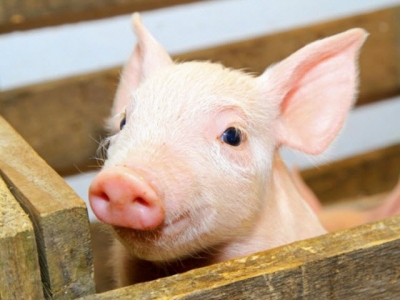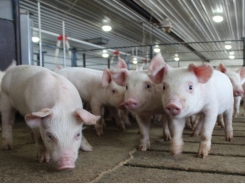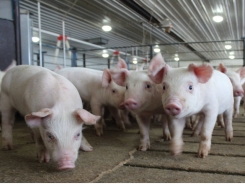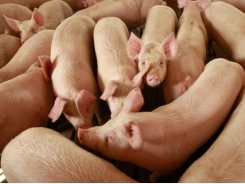Piglet gut health linked to high feed intake

The villius length in piglets at 5 days after weaning that are getting different amounts of dry matter (grams/day). This demonstrates that piglets can keep their villius length after weaning when they have a high enough energy intake.
Post-weaned piglets have less intestinal damage with proper feed consumption levels.
Piglet gut health post-weaning research and growth performance research has found that high feed intakes keep pathogens at bay and produce healthy pigs.
Maintaining healthy piglet gut levels with antibiotics and zinc is not a option for pig farmers as these are methods are being regulated and phased out. At the same time, Streptococci rather than E. coli seem to be an increasing cause of disease and piglet mortality.
High feed intake, gut health
Despite improvements in litter size and pre-weaning growth rates, the performance of piglets post weaning has not increased in recent years nor has it kept pace with genetic improvements. For example, the post weaning daily gain in the Netherlands in 2005 was 329g/d. In 2011 this was 325g/d (source: Agrovision).
Research has indicated that high feed intakes help piglets to digest and absorb nutrients like protein and starch, leading to the desired growth. When most nutrients are absorbed, there is not much substrate left over further down the intestine, so curbing the proliferation of disease-causing pathogens like E. coli.
The small intestine of a weaned piglet is about seven meters long and is covered by finger shaped, 0.5 mm long protrusions called villi (see, Figure 1). These villi give the intestine its enormous surface.
After weaning the intestine often gets damaged leading to leakage (Smith et al. 2010). This leakage causes toxins and bacteria (like Streptococci) to pass via the intestinal wall to the blood and then to the organs where they cause disease (Kim et al., 2012) as shown in Figure 2 and Figure 3.
Researchers have found that there is less intestinal damage in post-weaned piglets where feed intake is high enough (Verdonk et al. 2007). Figure 1 shows that higher dry matter intakes lead to longer intestinal villi.
Recently, research at the Provimi research centre De Viersprong in The Netherlands used a method to measure intestinal leakage. Piglets received an oral dosage of lactulose – a sugar that they don’t normally digest or absorb so it doesn’t get into the blood, unless the intestine is damaged, in which case it will leak into the blood and excreted by the kidneys to the urine. The amount of lactulose in the urine is used as a measure for intestinal damage.
The more lactulose that is recovered in the urine, the more the intestinal damage. It was demonstrated that a high feed intake in piglets leads to healthier intestines that are less permeable to undesired substances as shown in Figure 4.
Piglet feed flavor research
By far the most effective measure of increasing post weaning feed intake is to add spray-dried blood plasma to the piglet feed. As a rule of thumb, every 20g of plasma included in the feed increases feed intake by 10% in the first two weeks post weaning (van Dijk, 2008). Researchers have found that plasma improves the intestinal barrier function and reduces diarrhea (Smith et al. 2009). It is possible that plasma stimulates feed intake in piglets because they like the taste and smell of it.
Wageningen University in the Netherlands has published research recently on increasing feed intake of piglets by teaching them to recognize the feed taste and smell (Oostindjer 2011). The specific taste/smell of the feed was created by adding a certain flavor (Anise).
One group of sows was given the flavor in the final weeks of gestation and/or lactation feed, with the control sows’ feed omitting the flavor. The piglets originating from the different treatment groups of sows were monitored post weaning.
In the following preference trial, piglets post weaning were given a choice of feed; one containing the flavor and one without it. Piglets from sows that had the flavor in the gestation feed had a higher feed intake during the first three days after weaning.
They also showed higher growth rates and less diarrhea. All the findings were statistically significant. It is believed that the piglets recognized the flavor consumed when they were in the sows’ uteruses.
Creep feed intake
In another experiment, this phenomenon was demonstrated for creep feed intake. In this trial, sows were given feed flavored with Cinergy, a mix of essential oils, at the end of gestation and in lactation. The control group consisted of sows that did not get Cinergy in their diet.
The piglets were offered two types of creep feed that they could choose from: one with and one without Cinergy. The piglets originating from the sows that had Cinergy in their diets showed a significantly higher preference for the creep feed containing Cinergy, and their total creep feed was numerically higher than the piglets coming from the control sows (344g/piglet compared to 282 g/piglet).
These findings show that piglets feed intake, growth performance and health before and after weaning, can be improved by putting the same beneficial flavor in the feed during the last weeks of gestation and during lactation, as well as in the piglet creep, pre-starter and weaner feed.
Piglet growth study
At Sterksel experimental farm in the Netherlands, a trial was recently completed that showed growth rates improved and the post weaning dip avoided where milk replacer was fed post weaning (Van der Peet-Schwering et al. 2011).
A control group, fed only a weaner feed, was compared with a group fed weaner feed plus milk replacer for six days. The control group ate about 0.5 times their maintenance requirement at day one post weaning compared to the milk replacer group that ate about three times their maintenance requirement.
From day seven to 14 post weaning, the milk replacer piglets grew significantly faster than the control piglets, gaining 394g/day compared with the control group at 355 g/d. The group fed milk replacer also had a significantly better energy conversion ratio of 1.44 compared with 1.53 for the control group. At the end of the experiment at day 35 post weaning, the milk replacer fed piglets still grew 7% faster than the control piglets.
All the research points to the conclusion that low feed intake after weaning can be detrimental for piglet health and growth performance and boosting feed intake will help prevent a shortening of the intestinal villi and the leakage of bacteria from the intestine into the organs. Developing a taste for beneficial flavors and feeds during gestation and feeding milk replacer post weaning as well as during the lactation are new possibilities to increase feed intake in piglets.
Related news
Tools

Phối trộn thức ăn chăn nuôi

Pha dung dịch thủy canh

Định mức cho tôm ăn

Phối trộn phân bón NPK

Xác định tỷ lệ tôm sống

Chuyển đổi đơn vị phân bón

Xác định công suất sục khí

Chuyển đổi đơn vị tôm

Tính diện tích nhà kính

Tính thể tích ao




 Replacing whey protein concentrate in piglet formulas
Replacing whey protein concentrate in piglet formulas  Swine vaccine may benefit humans
Swine vaccine may benefit humans